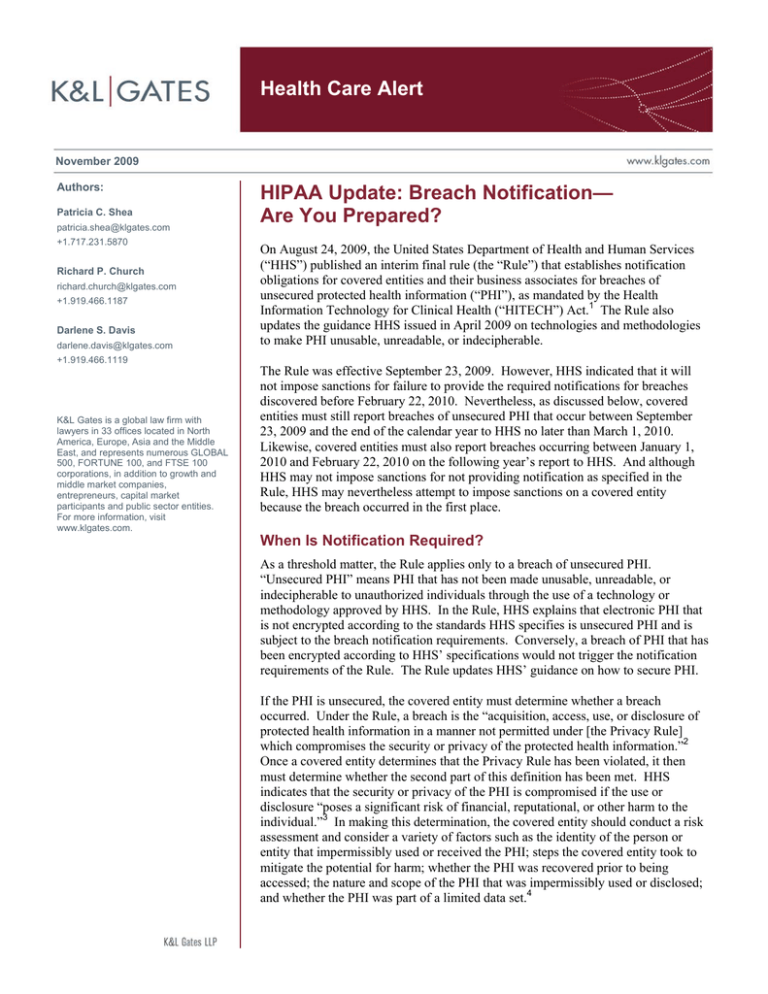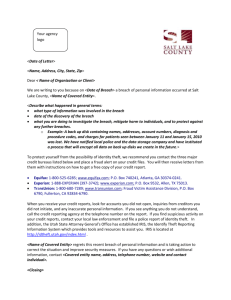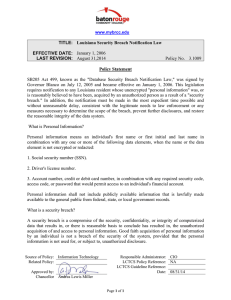
Health Care Alert
November 2009
Authors:
Patricia C. Shea
patricia.shea@klgates.com
+1.717.231.5870
Richard P. Church
richard.church@klgates.com
+1.919.466.1187
Darlene S. Davis
darlene.davis@klgates.com
+1.919.466.1119
K&L Gates is a global law firm with
lawyers in 33 offices located in North
America, Europe, Asia and the Middle
East, and represents numerous GLOBAL
500, FORTUNE 100, and FTSE 100
corporations, in addition to growth and
middle market companies,
entrepreneurs, capital market
participants and public sector entities.
For more information, visit
www.klgates.com.
HIPAA Update: Breach Notification—
Are You Prepared?
On August 24, 2009, the United States Department of Health and Human Services
(“HHS”) published an interim final rule (the “Rule”) that establishes notification
obligations for covered entities and their business associates for breaches of
unsecured protected health information (“PHI”), as mandated by the Health
Information Technology for Clinical Health (“HITECH”) Act.1 The Rule also
updates the guidance HHS issued in April 2009 on technologies and methodologies
to make PHI unusable, unreadable, or indecipherable.
The Rule was effective September 23, 2009. However, HHS indicated that it will
not impose sanctions for failure to provide the required notifications for breaches
discovered before February 22, 2010. Nevertheless, as discussed below, covered
entities must still report breaches of unsecured PHI that occur between September
23, 2009 and the end of the calendar year to HHS no later than March 1, 2010.
Likewise, covered entities must also report breaches occurring between January 1,
2010 and February 22, 2010 on the following year’s report to HHS. And although
HHS may not impose sanctions for not providing notification as specified in the
Rule, HHS may nevertheless attempt to impose sanctions on a covered entity
because the breach occurred in the first place.
When Is Notification Required?
As a threshold matter, the Rule applies only to a breach of unsecured PHI.
“Unsecured PHI” means PHI that has not been made unusable, unreadable, or
indecipherable to unauthorized individuals through the use of a technology or
methodology approved by HHS. In the Rule, HHS explains that electronic PHI that
is not encrypted according to the standards HHS specifies is unsecured PHI and is
subject to the breach notification requirements. Conversely, a breach of PHI that has
been encrypted according to HHS’ specifications would not trigger the notification
requirements of the Rule. The Rule updates HHS’ guidance on how to secure PHI.
If the PHI is unsecured, the covered entity must determine whether a breach
occurred. Under the Rule, a breach is the “acquisition, access, use, or disclosure of
protected health information in a manner not permitted under [the Privacy Rule]
which compromises the security or privacy of the protected health information.”2
Once a covered entity determines that the Privacy Rule has been violated, it then
must determine whether the second part of this definition has been met. HHS
indicates that the security or privacy of the PHI is compromised if the use or
disclosure “poses a significant risk of financial, reputational, or other harm to the
individual.”3 In making this determination, the covered entity should conduct a risk
assessment and consider a variety of factors such as the identity of the person or
entity that impermissibly used or received the PHI; steps the covered entity took to
mitigate the potential for harm; whether the PHI was recovered prior to being
accessed; the nature and scope of the PHI that was impermissibly used or disclosed;
and whether the PHI was part of a limited data set.4
Health Care Alert
Additionally, three situations are statutorily excepted
from the definition of a breach: (1) certain
unintentional acquisition, access, or use of
information by a workforce member or person acting
under the authority of the covered entity; (2) certain
inadvertent disclosures among persons similarly
authorized to access PHI at the covered entity; or (3)
where the recipient would not reasonably have been
able to retain the information.5
A covered entity that determines that a breach did
not occur based on its assessment that risk of harm
was not significant or that an exception applies
should maintain documentation supporting its
determination, as HHS has indicated that the burden
is on the entity to prove notification was not
required.6
Who Must Be Notified?
Individual Notification.7 Covered entities must
notify each individual whose unsecured PHI has
been or is reasonably believed to have been
breached. Unless delayed by law enforcement,
notification is required without unreasonable delay
and in no instance later than sixty (60) calendar
days after discovery of the breach. A breach is
considered discovered on the first day a covered
entity knew or, by exercising reasonable
diligence, would have known of the breach. Any
workforce member’s knowledge is attributable to
the covered entity, unless that individual
committed the breach. Further, HHS has
indicated that covered entities are required to
implement reasonable systems for the detection of
breaches.
The individual notification should be written in plain
language and include, to the extent possible: (1) a
brief description of what happened, including the
date of the breach and date it was discovered; (2) a
description of the types of unsecured PHI involved
in the breach; (3) steps individuals should take to
mitigate potential harm; (4) steps the covered entity
is taking to investigate the breach, mitigate harm,
and protect against additional breaches; and (5) a
contact person at the covered entity to receive
questions or provide additional information. The
covered entity is required to provide written notice
by first-class mail to an individual’s last known
address or by email consistent with an individual’s
agreement to receive electronic notice, if any. If an
individual is deceased, the written notice must be
sent to his or her next of kin or personal
representative.8 Additionally, if a covered entity
suspects imminent misuse of the PHI, individuals
may also be contacted by telephone or other means.
If the covered entity has out-of-date or insufficient
contact information for fewer than ten (10)
individuals, the covered entity may provide
substitute notice by either (1) an alternative form of
written notice, (2) telephone, or (3) other means
reasonably calculated to reach the individual. If ten
(10) or more individuals cannot be contacted, the
covered entity must provide notice through a
conspicuous posting on its web-based home page
for at least ninety (90) days or a conspicuous notice
in major print or broadcast media in the geographic
area where individuals affected by the breach likely
reside. The post or media notice must include a
toll-free phone number active for at least ninety (90)
days for an individual to call to learn if his or her
unsecured PHI might have been included in the
breach.
Media Notification.9 In addition to providing notice
to affected individuals, if more than 500 residents of
a state or jurisdiction are affected by a breach, the
covered entity must also notify prominent media
outlets serving that state or jurisdiction. Unless
delayed by law enforcement, such notification must
be made without unreasonable delay and in no
instance later than sixty (60) calendar days after the
breach is discovered. The notification must include
the same information identified above that is
required in an individual notification as well as a
toll-free contact number.
Notification to the Secretary.10 If 500 or more
individuals are affected, unless delayed by law
enforcement, the covered entity must also notify the
HHS Secretary concurrently with the notifications
sent to individuals. HHS will post information
about such large breach notices on its website. For
breaches that involve fewer than 500 individuals,
the covered entity must maintain a log or other
documentation identifying each breach and submit
a report on each breach to HHS within sixty (60)
days after the end of the calendar year in the
format specified by HHS. HHS has recently
posted a reporting form on its website for covered
November 2009
2
Health Care Alert
entities to report breaches affecting any number of
individuals.11 To make certain that the annual
reports of breaches include all necessary information
about each breach, covered entities should look to
the form on the HHS website to develop a complete
log or other running documentation on breaches
involving less than 500 individuals.
Breaches Discovered by Business
Associates
Under the Rule, covered entities must also provide
notice of breaches discovered by their business
associates. When determining whether a breach has
occurred, business associates follow the same
process described above for covered entities. HHS
indicates that the required notices under the Rule
may come directly from the business associate
pursuant to an agreement with a covered entity or
the business associate may report such breaches to
the covered entity, which will in turn provide the
required notices under the Rule.
In the latter instance, the business associate must
notify the affected covered entity of a breach
without unreasonable delay and in no instance more
than sixty (60) days after the breach is discovered.
If the business associate is an agent of the covered
entity (determined in accordance with the federal
common law of agency), the date of discovery for
the covered entity is considered to be the date the
business associate knew or should have known of
the breach. If the business associate is not deemed
an agent of the covered entity, the covered entity
may treat the date on which the business associate
provided it notice as its date of discovery.12
What Should Covered Entities and
Business Associates Be Doing Before
the Compliance Deadline?
While the Rule is currently effective and covered
entities and business associates must comply with
its requirements, HHS has indicated that it will not
impose sanctions under the Rule until February 22,
2010. During this period, covered entities should:
1. Develop and adopt a breach notification policy
consistent with the Rule, including procedures
to detect breaches;
2. Conduct workforce training on breach detection
and notification13;
3. Assess the adequacy of breach notification
requirements in existing and new business
associates agreements, and modify as
appropriate;
4. Log breaches affecting fewer than 500
individuals that occur after September 23, 2009
for reporting to HHS annually within the first
60 days of each calendar year; and
5. To the extent possible, begin implementing
notification procedures to individuals, and for
breaches involving more than 500 individuals,
to the media and HHS so that the workforce is
familiar with the process before the
enforcement period begins.
Additionally, many states have implemented
privacy and security requirements related to
sensitive health or consumer information that may
also have breach notification requirements.
Covered entities should confirm that policies and
procedures implemented under the Rule are
consistent with all state or federal requirements that
may otherwise be applicable to the covered entity.
November 2009
3
Health Care Alert
Anchorage Austin Beijing Berlin Boston Charlotte Chicago Dallas Dubai Fort Worth Frankfurt Harrisburg Hong Kong London
Los Angeles Miami Newark New York Orange County Palo Alto Paris Pittsburgh Portland Raleigh Research Triangle Park
San Diego San Francisco Seattle Shanghai Singapore Spokane/Coeur d’Alene Taipei Washington, D.C.
K&L Gates is a global law firm with lawyers in 33 offices located in North America, Europe, Asia and the Middle East, and represents numerous
GLOBAL 500, FORTUNE 100, and FTSE 100 corporations, in addition to growth and middle market companies, entrepreneurs, capital market
participants and public sector entities. For more information, visit www.klgates.com.
K&L Gates comprises multiple affiliated partnerships: a limited liability partnership with the full name K&L Gates LLP qualified in Delaware and
maintaining offices throughout the United States, in Berlin and Frankfurt, Germany, in Beijing (K&L Gates LLP Beijing Representative Office), in
Dubai, U.A.E., in Shanghai (K&L Gates LLP Shanghai Representative Office), and in Singapore; a limited liability partnership (also named K&L
Gates LLP) incorporated in England and maintaining offices in London and Paris; a Taiwan general partnership (K&L Gates) maintaining an office in
Taipei; and a Hong Kong general partnership (K&L Gates, Solicitors) maintaining an office in Hong Kong. K&L Gates maintains appropriate
registrations in the jurisdictions in which its offices are located. A list of the partners in each entity is available for inspection at any K&L Gates office.
This publication is for informational purposes and does not contain or convey legal advice. The information herein should not be used or relied upon
in regard to any particular facts or circumstances without first consulting a lawyer.
©2009 K&L Gates LLP. All Rights Reserved.
1
Breach Notification for Unsecured Protected Health
Information, 74 Fed. Reg. 42,740 (Aug. 24, 2009).
2
45 C.F.R. § 164.402.
3
Id.
4
If a limited data set also excluded zip codes and dates of
birth, HHS has deemed that the covered entity may
conclude that no breach occurred.
5
45 C.F.R. § 164.402.
6
See id. § 164.414.
7
See id. § 164.404.
8
The requirements for substitute notice do not apply to next
of kin or personal representatives.
9
See 45 C.F.R. § 164.406.
10
See id. § 164.408.
11
See
http://www.hhs.gov/ocr/privacy/hipaa/administrative/breach
notificationrule/index.html.
12
See 45 C.F.R. § 164.410.
13
See id. § 164.414.
November 2009
4




